启发式算法常见的有三种:模拟退火、遗传算法、神经网络
本篇文章主要涉及模拟退火和遗传算法。
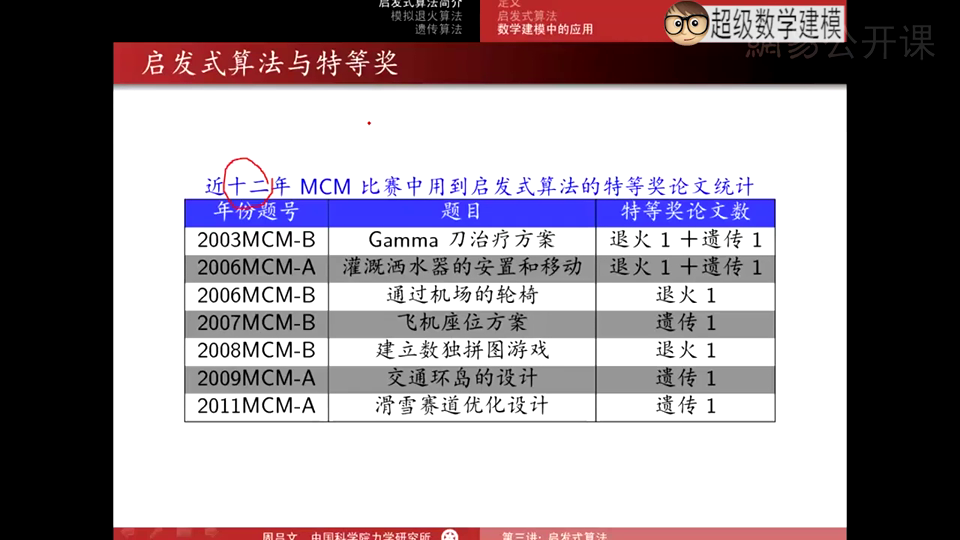
事实证明,即使是老算法也能用的很妙。
经典问题:旅行商问题(TSP)
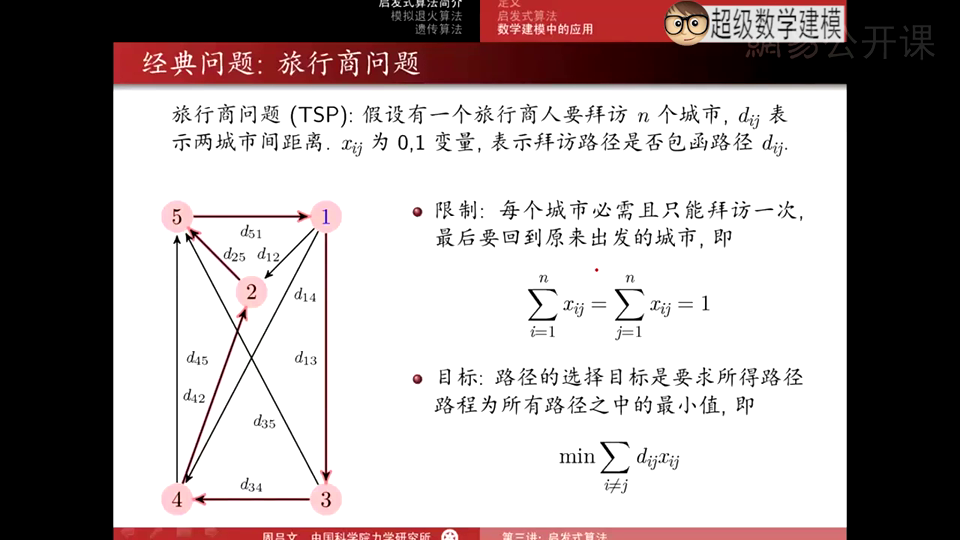
每个城市只有一个箭头指进,一个箭头指出,即入度和出度均为1。
模拟退火算法原理
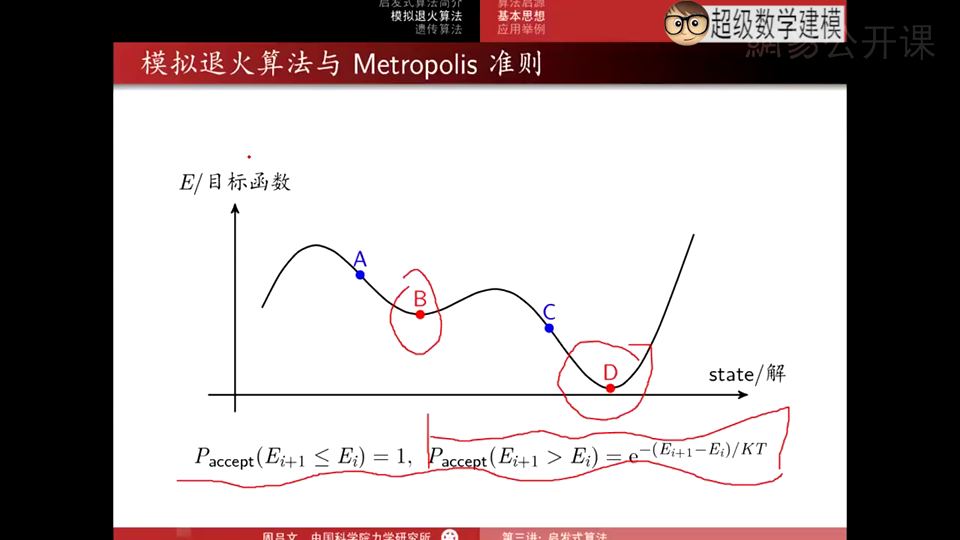
模拟退火算法的好处就在于,如果你设置初始点为A点,会有一定概率跳出B点从而到达D点,而贪心算法不行(除非设置初始点在C点)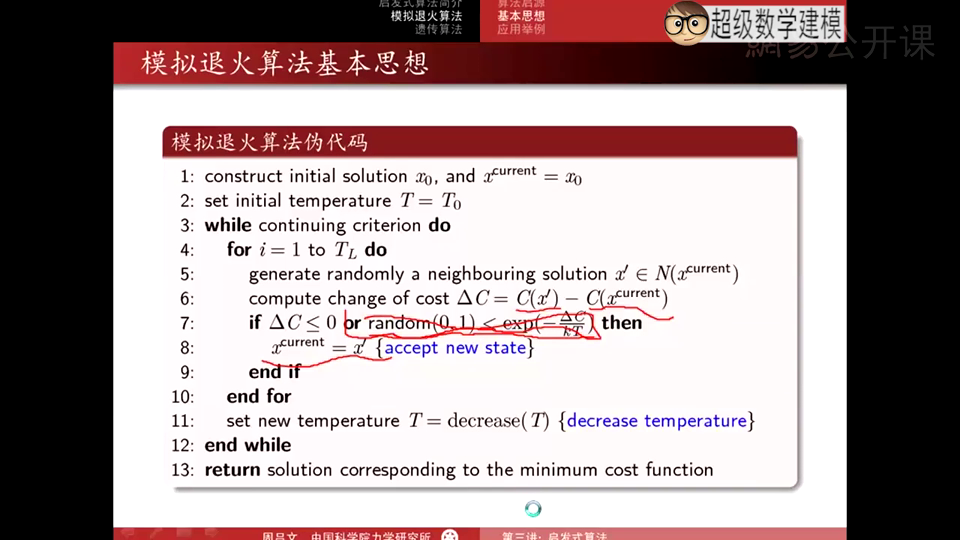
图中or random...即为metropolis准则,也是模拟退火和贪心算法的根本区别。
模拟退火算法设计要素
在设计模拟退火算法解决问题中,我们需要注意以下几个要素:

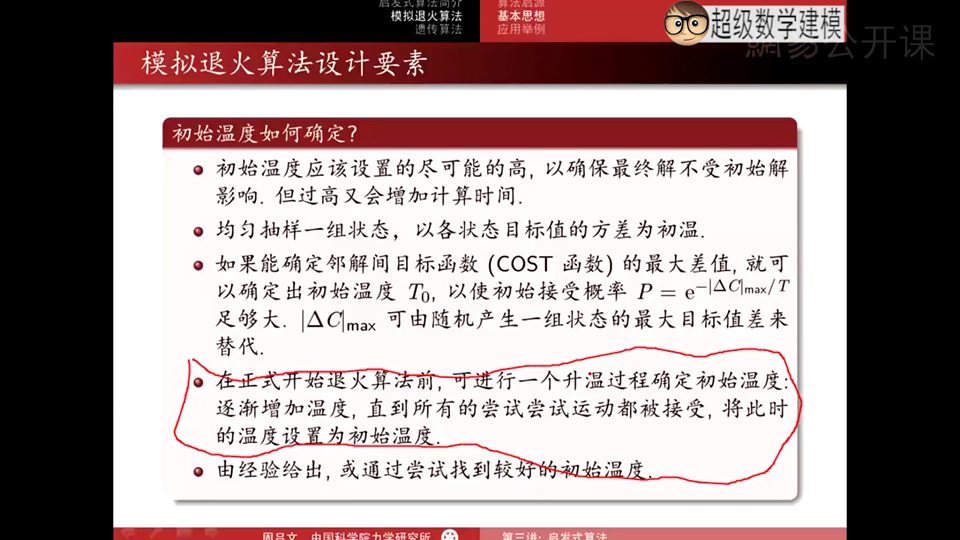
确定初始温度的方法中,多设几个温度,逐渐增加温度是最靠谱的。

如果解空间非常小,等温步数可能要小一点;如果解空间非常大,等温步数可能要大一点。
虽然等温步数受温度影响,但一般情况下,不论低温和高温时,等温步数都设大一点。
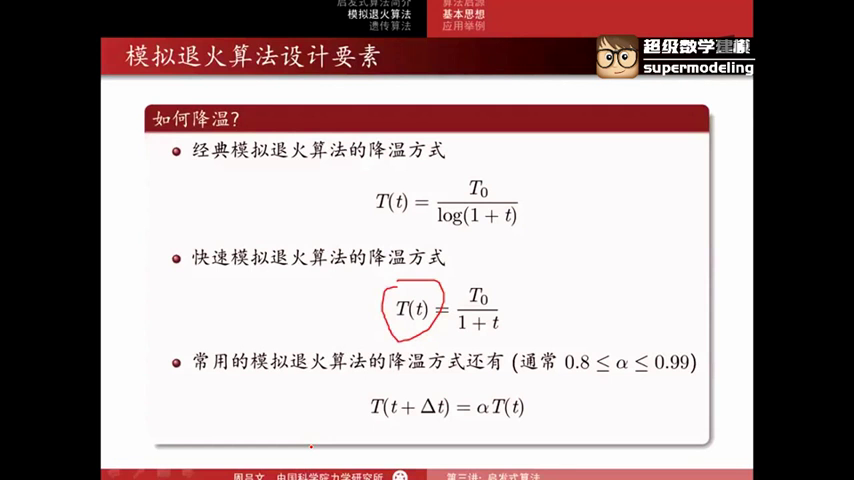
三种降温方式

用模糊退火来求解TSP问题
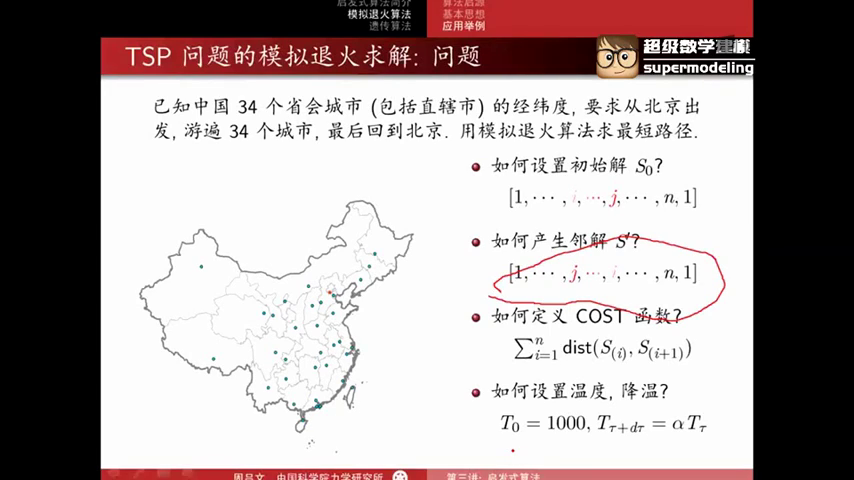
代码详解
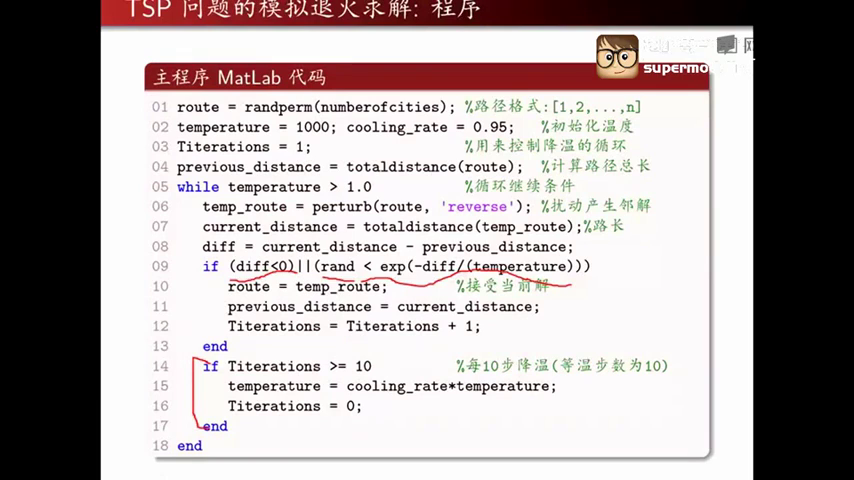
perturb和totaldistance是自己建立的函数
perturb用来产生邻解,totaldistance求总长。
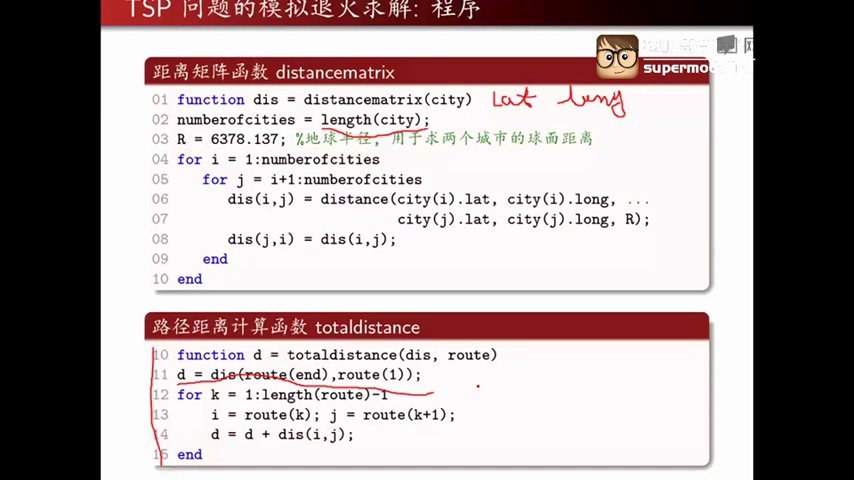
distance函数中,输入两点经纬度和地球半径,即可求出两点间的球面距离。
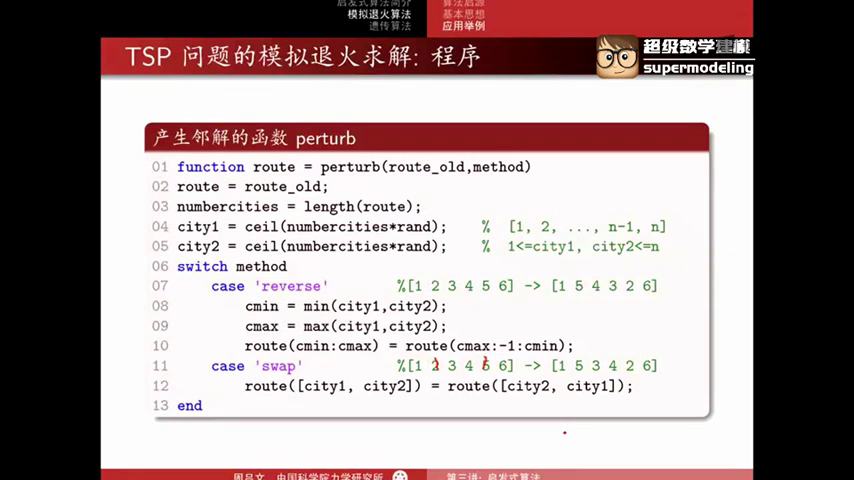
ceil(numbercities*rand)用来产生1到37之间的任意数。
产生邻解的方法有两种,一种是“reverse”,另一种是“swap”。
代码实现
main.m
%
% This is the main script to finds a (near) optimal solution to the Traveling
% Salesman Problem (TSP), by setting up a Simulated Annealing (SA) to search
% for the shortest route (least distance for the salesman to travel to each
% city exactly once and return to the starting city).
%
% Author: zhou lvwen Email: zhou.lv.wen@gmail.com
% Release Date: November 12, 2012
%
clear;clc;
load china; % geographic information
plotcities(province, border, city); % draw the map of China
numberofcities = length(city); % number of cities
% distance matrix: dis(i,j) is the distance between city i and j.
dis = distancematrix(city);
temperature = 1000; % Initialize the temperature.
cooling_rate = 0.94; % cooling rate
iterations = 1; % Initialize the iteration number.
% Initialize random number generator with "seed".
rand('seed',0);
% Initialize the route by generate a sequence of random
route = randperm(numberofcities);
% This is objective function, the total distance for the routes.
previous_distance = totaldistance(route,dis);
% This is a flag used to cool the current temperature after 100 iterations
temperature_iterations = 1;
% This is a flag used to plot the current route after 200 iterations
plot_iterations = 1;
% plot the current route
plotroute(city, route, previous_distance, temperature);
while 1.0 < temperature
% generate randomly a neighbouring solution
temp_route = perturb(route,'reverse');
% compute total distance of the temp_route
current_distance = totaldistance(temp_route, dis);
% compute change of distance
diff = current_distance - previous_distance;
% Metropolis Algorithm
if (diff < 0) || (rand < exp(-diff/(temperature)))
route = temp_route; %accept new route
previous_distance = current_distance;
% update iterations
temperature_iterations = temperature_iterations + 1;
plot_iterations = plot_iterations + 1;
iterations = iterations + 1;
end
% reduce the temperature every 100 iterations
if temperature_iterations >= 100
temperature = cooling_rate*temperature;
temperature_iterations = 0;
end
% plot the current route every 200 iterations
if plot_iterations >= 200
plotroute(city, route, previous_distance,temperature);
plot_iterations = 0;
end
end
% plot the final solution
plotroute(city, route, previous_distance,temperature);
distancematrix.m
function dis = distancematrix(city)
% DISTANCEMATRIX
% dis = DISTANCEMATRIX(city) return the distance matrix, dis(i,j) is the
% distance between city_i and city_j
numberofcities = length(city);
R = 6378.137; % The radius of the Earth
for i = 1:numberofcities
for j = i+1:numberofcities
dis(i,j) = distance(city(i).lat, city(i).long, ...
city(j).lat, city(j).long, R);
dis(j,i) = dis(i,j);
end
end
function d = distance(lat1, long1, lat2, long2, R)
% DISTANCE
% d = DISTANCE(lat1, long1, lat2, long2, R) compute distance between points
% on sphere with radians R.
%
% Latitude/Longitude Distance Calculation:
% http://www.mathforum.com/library/drmath/view/51711.html
y1 = lat1/180*pi; x1 = long1/180*pi;
y2 = lat2/180*pi; x2 = long2/180*pi;
dy = y1-y2; dx = x1-x2;
d = 2*R*asin(sqrt(sin(dy/2)^2+sin(dx/2)^2*cos(y1)*cos(y2)));
totaldistance.m
function d = totaldistance(route, dis)
% TOTALDISTANCE
% d = TOTALDISTANCE(route, dis) calculate total distance of a route with
% the distance matrix dis.
d = dis(route(end),route(1)); % closed path
for k = 1:length(route)-1
i = route(k);
j = route(k+1);
d = d + dis(i,j);
endperturb.m
function route = perturb(route_old, method)
% PERTURB
% route = PERTURB(route_old, method) generate randomly a neighbouring route by
% perturb old route. perturb methods:
% ___________ ___________
% 1. reverse: [1 2 3 4 5 6 7 8 9] -> [1 2 8 7 6 5 4 3 9]
% _ _ _ _
% 2. swap: [1 2 3 4 5 6 7 8 9] -> [1 2 8 4 5 6 7 3 9]
route = route_old;
numbercities = length(route);
city1 = ceil(numbercities*rand);
city2 = ceil(numbercities*rand);
switch method
case 'reverse'
citymin = min(city1,city2);
citymax = max(city1,city2);
route(citymin:citymax) = route(citymax:-1:citymin);
case 'swap'
route([city1, city2]) = route([city2, city1]);
end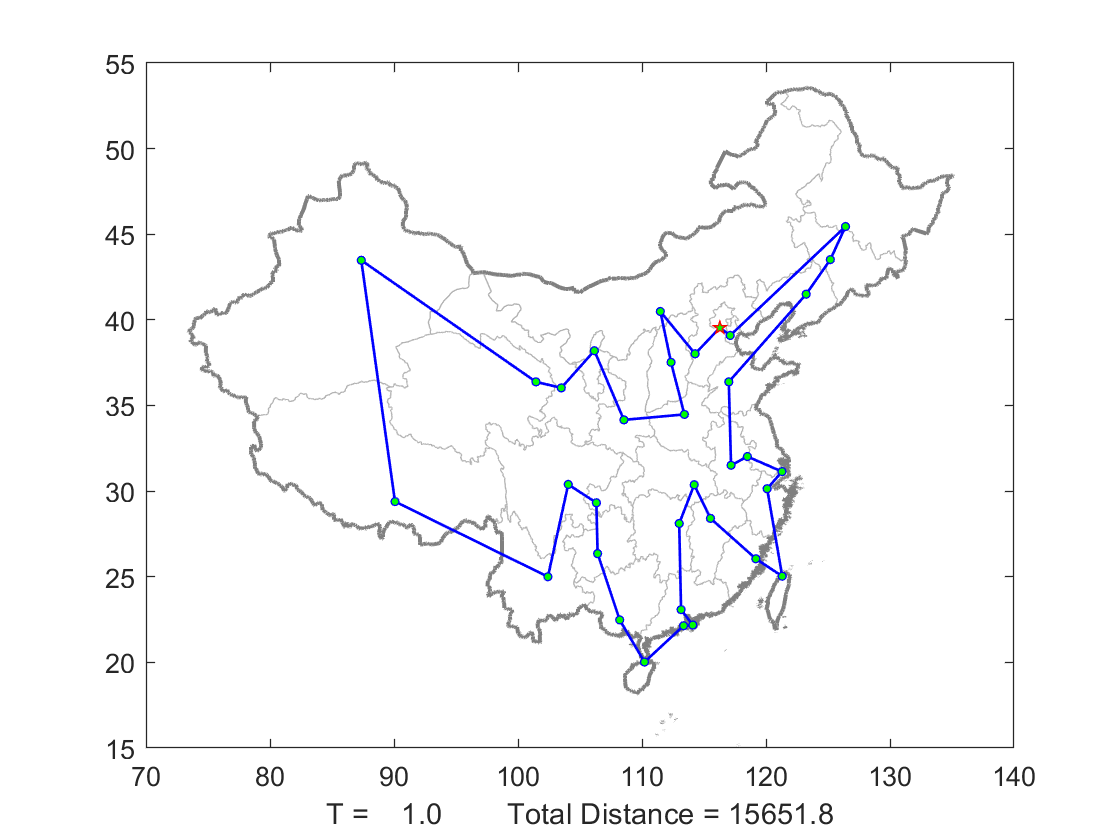
退火算法不一定是最优解,但却是空间和时间花费比较小的算法。
实际上解决TSP问题的最优解可用整数规划求得。
遗传算法原理
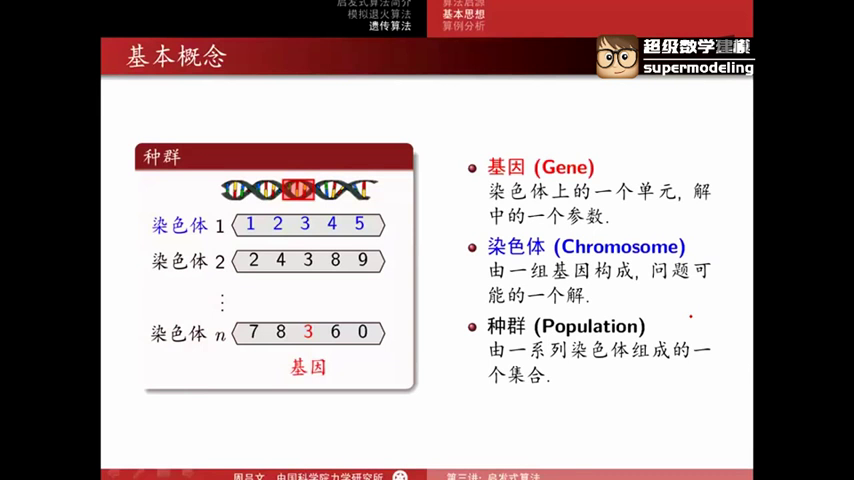
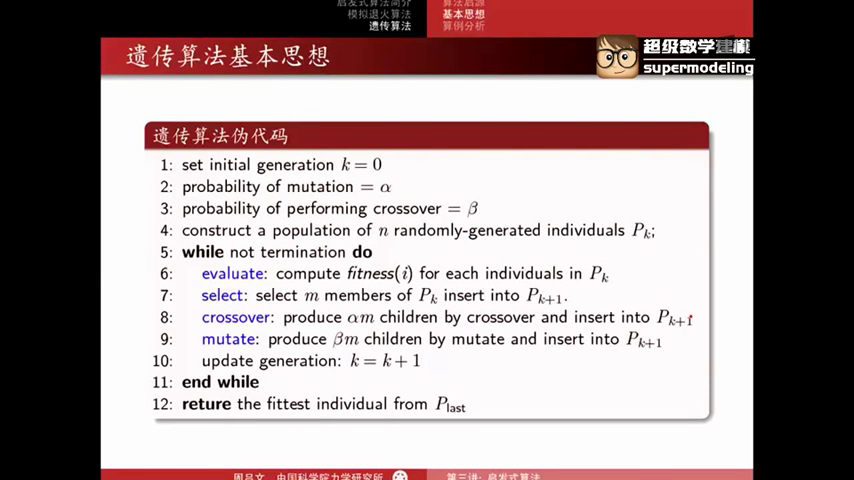
前四行分别为初代、变异概率、杂交概率、含有n个初始解的种群。
在最后一代中选出最优秀的一个。
与遗传算法有关的一些概念
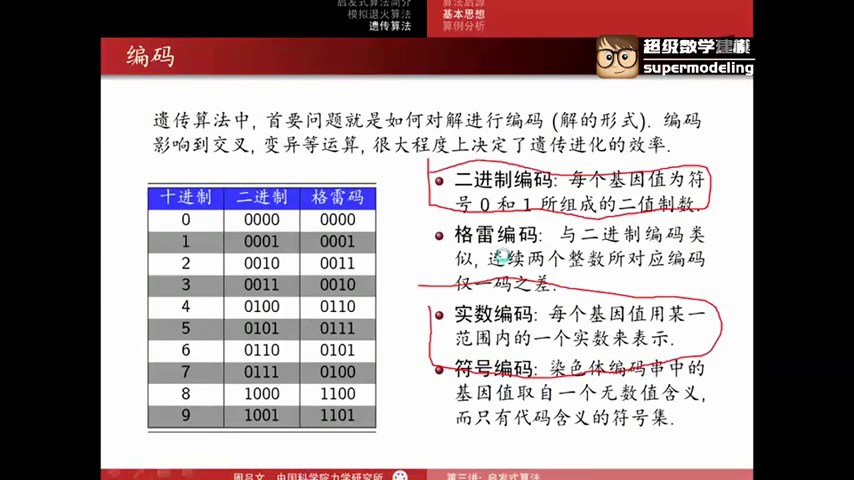
在编码中,实数编码和二进制编码是最常用到的。
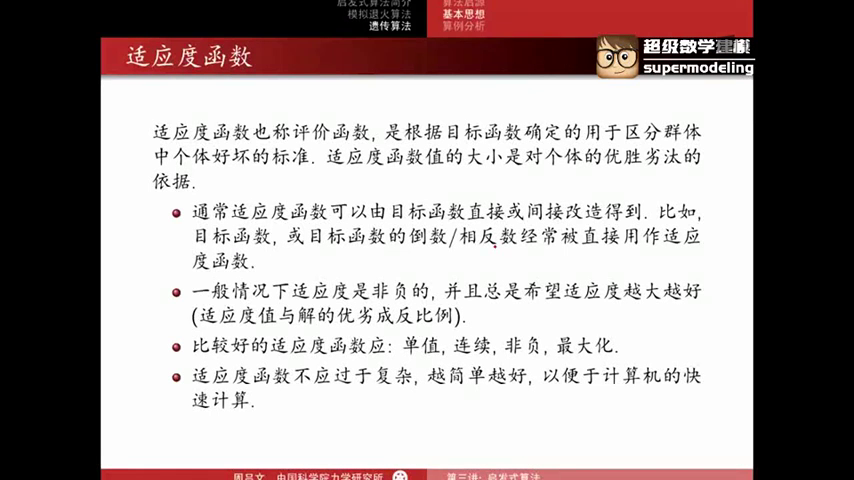
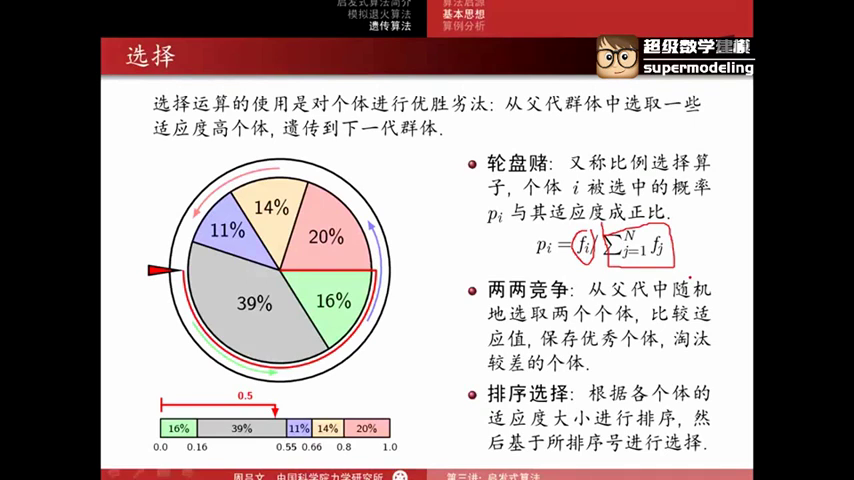
排序选择的随机性比较小一些,轮盘赌和两两竞争的随机性比较大一些。

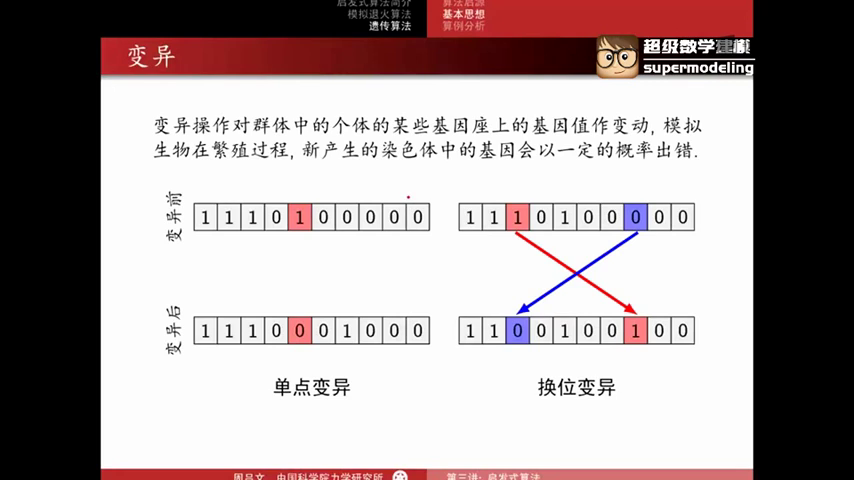
用遗传算法来求解TSP问题

这里为了让适应度函数足够小,取总距离的倒数。
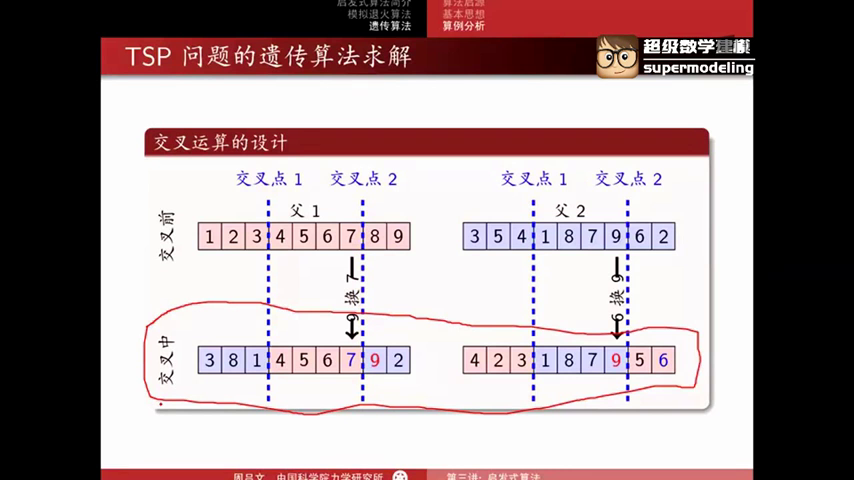
这里的交叉运算和先前的直接交叉有所差别。这和解的特征有所关联。将上面的4传给下面的1以后,下面的1变为4,但另一个原本的4与新的4重复,所以原本的4又变成1。
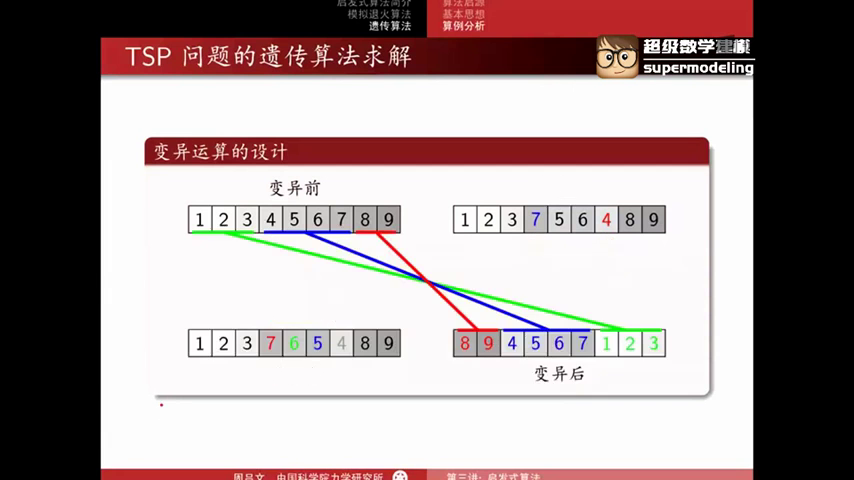
这里的变异和扰动有些类似。
代码详解
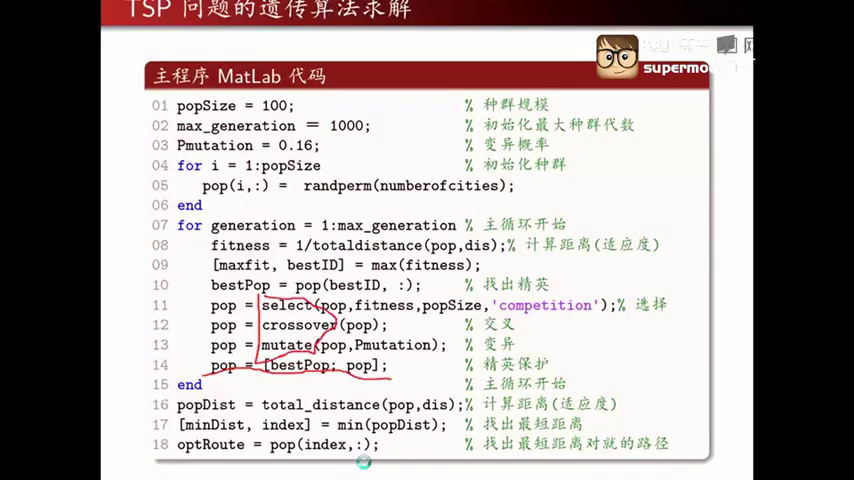
pop为初始化的种群
select选择 crossover交叉 mutate变异
第14行是为了将最好的解留在种群当中
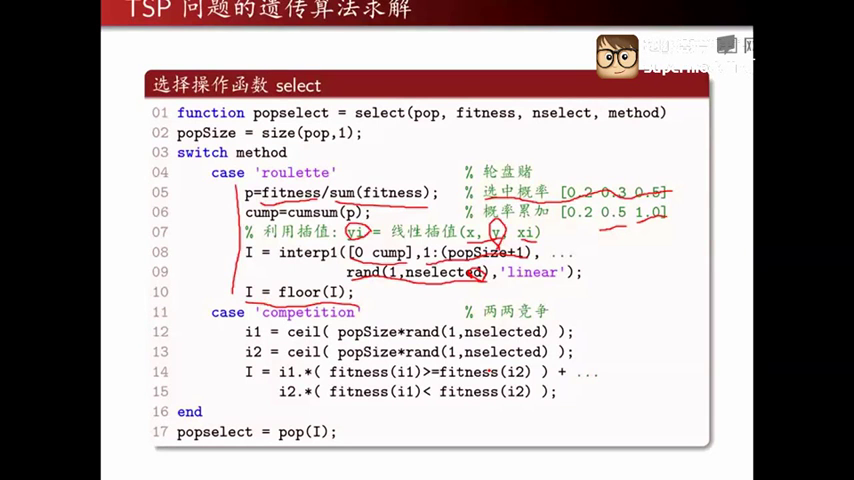
size(pop, 1)求出pop的行数,即种群的个数
第12行可理解为:在1至popSize的整数之间任意挑选nselect次(可重复)之后组成的数组。
interp1为线性插值函数
I是我们选择的行数,即我们选择了哪些个体。

InsertPoints决定了我们进行交叉操作的起点与终点。
具体交叉方式与前文所述类似。
待交叉结束后,将child1和child2插回children。
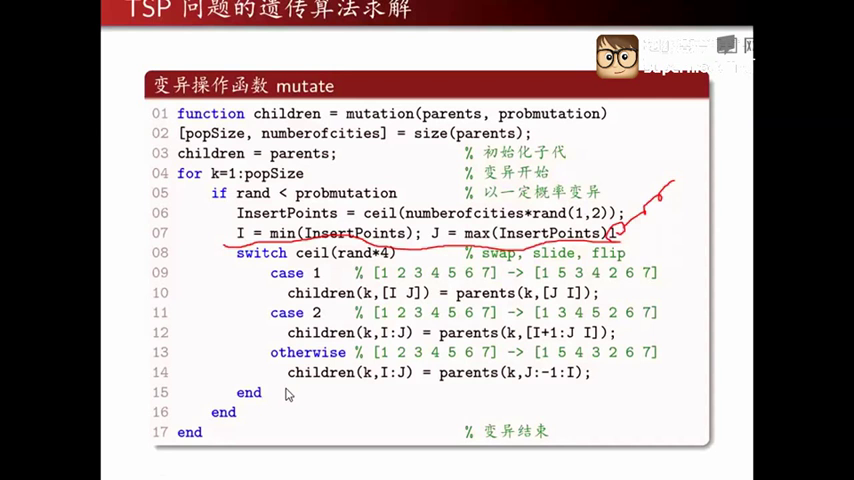
当rand小于probmutation时,发生变异,变异情况有三种,1/4的可能性swap,1/4的可能性slide,1/2的可能性flip。
代码实现
main.m
%
% This is the main script to finds a (near) optimal solution to the Traveling
% Salesman Problem (TSP), by setting up a Genetic Algorithm (GA) to search
% for the shortest route (least distance for the salesman to travel to each
% city exactly once and return to the starting city).
%
% Author: zhou lvwen Email: zhou.lv.wen@gmail.com
% Release Date: November 12, 2012
%
clear;clc;
load china; % geographic information
plotcities(province, border, city); % draw the map of China
numberofcities = length(city); % number of cities
% distance matrix: dis(i,j) is the distance between city i and j.
dis = distancematrix(city);
popSize = 100; % population size
max_generation = 1000; % number of generation
probmutation = 0.16; % probability of mutation
% Initialize random number generator with "seed".
rand('seed',103);
% Initialize the pop: start from random routes
pop = zeros(popSize,numberofcities);
for i=1:popSize
pop(i,:)=randperm(numberofcities);
end
for generation = 1:max_generation % generations loop
% evaluate: compute fitness(1/totaldistance) for each individuals in pop
popDist = totaldistance(pop,dis);
fitness = 1./popDist;
% find the best route & distance
[mindist, bestID] = min(popDist);
bestPop = pop(bestID, :); % best route
% update best route on figure:
if mod(generation,10)==0
plotroute(city, bestPop, mindist, generation)
end
% select (competition / roulette)
pop = select(pop, fitness, popSize,'competition');
% crossover
pop = crossover(pop);
% mutation
pop = mutation(pop, probmutation);
% save elitism(best path) and put it to next generation without changes
pop = [bestPop; pop];
end
% return the best route
[mindist, bestID]=min(popDist);
bestPop = pop(bestID, :);
% plot the final solution
plotroute(city, bestPop, mindist, generation);select.m
function popselected = select(pop, fitness, nselected, method)
% SELECT
% popselected = SELECT(pop, fitness, nselected, method) select the fittest
% individuals to survive to the next generation.
%
popSize = size(pop,1);
switch method
case 'roulette'
p=fitness/sum(fitness); % probabilities of select
cump=cumsum(p); % cumulative sum of probabilities
I = interp1([0 cump],1:(popSize+1),rand(1,nselected),'linear');
% random numbers from 1:nselected according probabilities
I = floor(I);
case 'competition'
% randomly generated two sets of population
i1 = ceil( popSize*rand(1,nselected) );
i2 = ceil( popSize*rand(1,nselected) );
% compare the fitness and select the fitter
I = i1.*( fitness(i1)>=fitness(i2) ) + ...
i2.*( fitness(i1)< fitness(i2) );
end
popselected=pop(I,:);
function children = crossover(parents)
% CROSSOVER
% children = CROSSOVER(parents) Replicate the mating process by crossing
% over randomly selected parents.
%
% Mapped Crossover (PMX) example:
% _ _ _
% [1 2 3|4 5 6 7|8 9] |-> [4 2 3|1 5 6 7|8 9] |-> [4 2 3|1 8 6 7|5 9]
% [3 5 4|1 8 7 6|9 2] | [3 5 1|4 8 7 6|9 2] | [3 8 1|4 5 7 6|9 2]
% | | | | |
% V | V | |
% [* 2 3|1 5 6 7|8 9] _| [4 2 3|1 8 6 7|* 9] _| V
% [3 5 *|4 8 7 6|9 2] [3 * 1|4 5 7 6|9 2] ... ... ...
%
[popSize, numberofcities] = size(parents);
children = parents; % childrens
for i = 1:2:popSize % pairs counting
parent1 = parents(i+0,:); child1 = parent1;
parent2 = parents(i+1,:); child2 = parent2;
% chose two random points of cross-section
InsertPoints = sort(ceil(numberofcities*rand(1,2)));
for j = InsertPoints(1):InsertPoints(2)
if parent1(j)~=parent2(j)
child1(child1==parent2(j)) = child1(j);
child1(j) = parent2(j);
child2(child2==parent1(j)) = child2(j);
child2(j) = parent1(j);
end
end
% two childrens:
children(i+0,:)=child1; children(i+1,:)=child2;
end
mutation.m
function children = mutation(parents, probmutation)
% MUTATION
% children = MUTATION(parents, probmutation) Replicate mutation in the
% population by selecting an individual with probability probmutation
%
% swap: _ _ slide: _ _________ flip: ---------->
% [1 2|3 4 5 6 7 8|9] [1 2|3 4 5 6 7 8|9] [1 2|3 4 5 6 7 8|9]
% _________ _ <----------
% [1 2|8 4 5 6 7 3|9] [1 2|4 5 6 7 8 3|9] [1 2|8 7 6 5 4 3|9]
%
[popSize, numberofcities] = size(parents);
children = parents;
for k=1:popSize
if rand < probmutation
InsertPoints = ceil(numberofcities*rand(1,2));
I = min(InsertPoints); J = max(InsertPoints);
switch ceil(rand*6)
case 1 % swap
children(k,[I J]) = parents(k,[J I]);
case 2 % slide
children(k,[I:J]) = parents(k,[I+1:J I]);
otherwise % flip
children(k,[I:J]) = parents(k,[J:-1:I]);
end
end
end
与模拟退火算法所获得的答案是一致的。(应该只是巧合……?)
模拟退火算法和遗传算法在本质上都是不断调整,寻求最优解的过程。
重点:多看伪代码,加深理解。
























 3480
3480











 被折叠的 条评论
为什么被折叠?
被折叠的 条评论
为什么被折叠?








